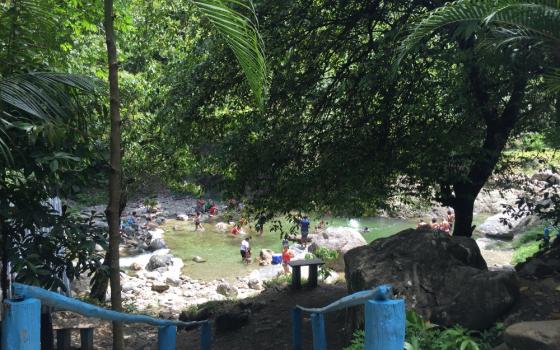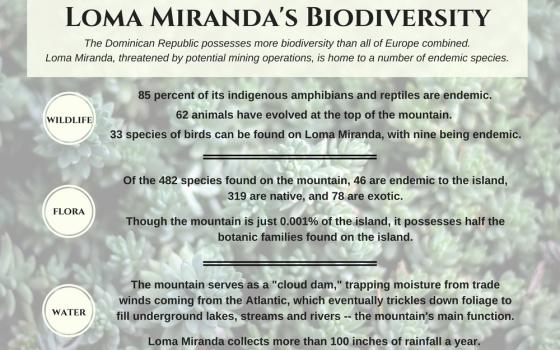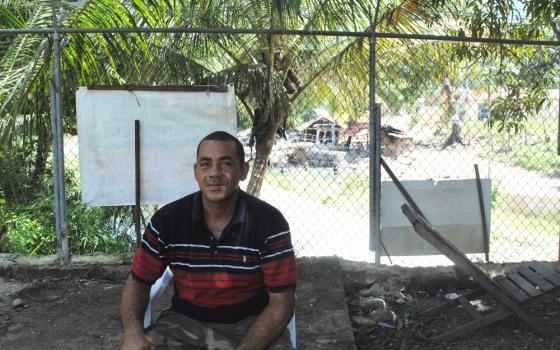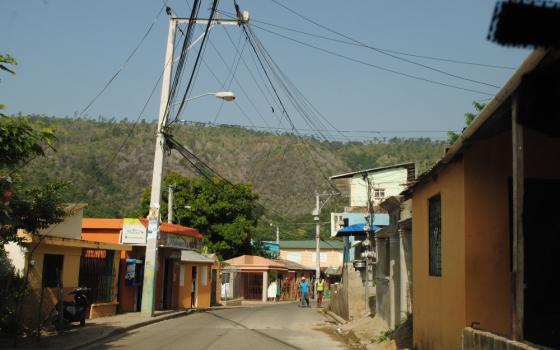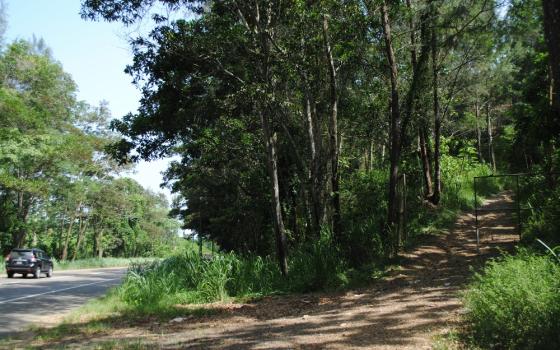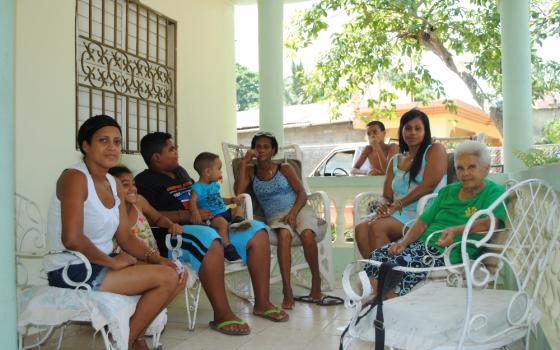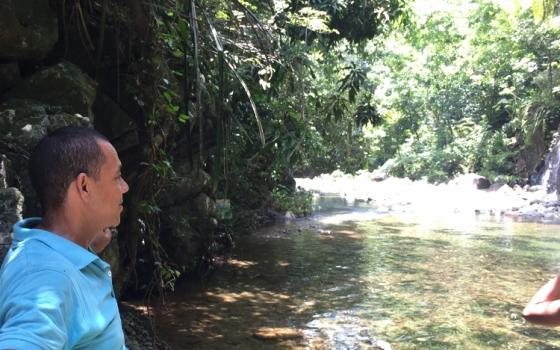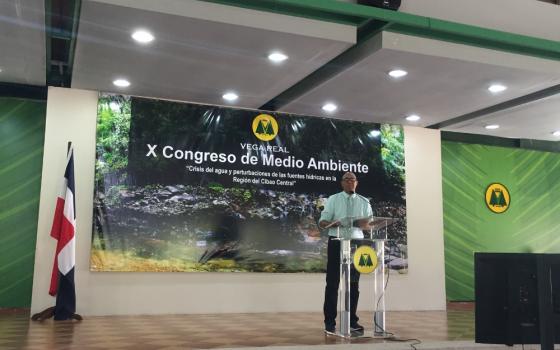Global Sisters Report is focusing a special series on mining and extractive industries and the women religious and other activists who work to limit damage and impact on people and the environment, through advocacy, action and policy. Pope Francis last year called for the entire mining sector to undergo "a radical paradigm change."
In knee-high rubber boots and a baggy T-shirt, Genaro Rodriguez guides three young women through the forests of Loma Miranda, one of the most biodiverse mountains in the Dominican Republic.
Rodriguez, who is known as the best local guide for such mountain excursions, now considers his job an existential one: He believes that firsthand appreciation of the natural beauty might help mobilize the national fight to preserve the mountain from potential mining operations.
"I drink that water, bathe with that water, live off that water," he said, pointing to the springs where the young women had jumped in to swim. "So why wouldn't I sacrifice myself for future generations to have that water?" he said. "Money only buys the cheap."
Loma Miranda is located 10.5 miles (about 17 km) outside the city of La Vega. Known as a "green curtain" that serves as a natural sponge for opposing trade winds, the mountain absorbs and collects humidity from clouds that hit vegetation, causing a unique phenomenon known as horizontal precipitation, in which moisture trickles down the plants and gathers into bodies of water.
Loma Miranda provides most of the local region's water and acts as a natural barrier, protecting surrounding communities from cyclones and other natural disasters, according to Vega Real, a national environmental cooperative.
The serenity of Loma Miranda belies the pitched battle currently taking place in the Dominican Republic: to designate the mountain a national park as a means to protect it from mining interests. The "water mine" — as locals often refer to the mountain — is rich with nickel in its subsoil, making it an attractive investment destination for foreign mining companies, namely Canada-based Falcondo of Americano Nickel Ltd., formally known as Falconbridge Dominicana.
Local residents say they are fighting an uphill battle against a government that appears to be aligned with powerful mining interests.
"This is the first social revolution on behalf of the environment in the Dominican Republic after its founding," said Yanio Concepción, president of Vega Real, which has preservation of Loma Miranda as its front-and-center issue. "It's a romantic, utopic fight, but it is based in reality, on Earth."
A survey by the Dominican news website Hoy found that more than 80 percent of the country's population (of about 10.5 million) is opposed to mining projects on Loma Miranda.
"We as Dominicans know that mining is important for the advancement of technology, of modern life," Sen. Euclides Sanchez, who represents La Vega, told Global Sisters Report. "And there are places where mines can be dug safely. But on an island as small as Española, mines — especially what's being considered for Loma Miranda — are invasive to the environment, and we have limitations, being one of two tiny countries sharing a tiny island."
"Economic power is blind, and being blind is dangerous when the Earth, especially our island, is fragile," he said.
The birth of a plan
Wearing a green trucker hat embroidered with "Miranda somos todos y todas" ("We are all Miranda"), a Loma Miranda T-shirt and rubber bracelets, Fr. Rogelio Cruz — a Catholic priest and vocal advocate for the preservation of Loma Miranda — said such mines put the island at risk of becoming a desert.
Just as Catholic sisters give voice to international extractive issues at the United Nations, Cruz brought forth a document to the U.N. in July, outlining the mountain's environmental clashes and pushing the struggle to an international stage.
"If we lose Loma Miranda, 22 other sites [in the Dominican Republic] become jeopardized by that precedent," he said. "Companies argue that mining could employ about 200 people, but more than 150,000 people would be negatively indirectly affected by the mining. The farmers, our food, hydroelectric power. . . . It's the source of all our irrigation, so we would literally turn into a desert."
Residents living at the base of the mountain look to Cotuí, a town an hour away, fearing the repercussions similar to the ones it suffered after Canadian-based Barrick-Gold reopened gold mines there in 2010.
In 2014, Hoy ran several tests in the Cotuí region and found that residents showed cyanide in their blood and urine, which experts said they absorbed either through respiration or by drinking the contaminated water. Residents must buy bottled water, which, for a day's worth, can cost up to 80 pesos. (Minimum wage in the public sector is about 86 pesos a day.)
To assess the environmental impact Falcondo's mines would have, President Danilo Medina contracted an independent researcher, Programa de Naciones Unides para el Desarollo (PNUD), in 2013. Though Medina promised he would respect the findings of a third-party evaluation, when PNUD discovered that 23 of Falcondo's 26 arguments for mining safely were inaccurate, he did not deny the company permission to continue exploring the land. GSR was unable to reach Falcondo for comment.
Area residents "feel tied by our hands and feet," said Escarlín Gutierrez, a local activist and president of the nongovernmental organization Agua y Vida (Water and Life), whose main cause is the preservation of Loma Miranda.
"What's going to happen to us, to our community that depends on Loma Miranda, to the ecology of the Dominican Republic? There's no guarantee that everything will work out, so all we can do is keep fighting," said Gutierrez, who named her 2-year-old daughter Miranda after the mountain. "It's not easy, fighting when the government and the powerful companies take advantage of our needs, of our hunger, of our ignorance."
Gutierrez said when Falcondo first arrived to Loma Miranda in 2013, 80 families were living in the region the company had scouted. Half the families were paid to relocate, eventually moving into the poorest neighborhoods of La Vega and transitioning from agricultural work to gathering garbage, she said. However, Falcondo built houses for the remaining 40 families on certain parts of land where they can continue to farm, mostly rice.
"That only happened due to outside pressure. They weren't going to do it themselves," Gutierrez said. "Those who were forced to leave would much rather live in Loma [Miranda], where the climate is better and where they had a peaceful life, schools, and a priest who could visit. But now their lives are totally changed. And what's our fear? That Falcondo will do the same to the rest of us.
"If our rivers dry up or become contaminated, where are we to go? Those with money can leave, but the poor — and there are plenty of them — will have to stay and likely become ill without food or water. And I think it's better to die in battle than to die complacent," she said.
Building a coalition to fight Falcondo was a process that lasted months, as locals were wary that those opposing the mine were merely organizing themselves to become negotiators with the large corporation. And the corporation did approach the community's leaders, Gutierrez said, offering the construction of a much-needed aqueduct or bridge, employment opportunities, and housing in exchange for their support of the mines. The community leadership turned them down, considering this an offensive bribe, she said.
"To this day, we will not give them social license to exploit [the mountain]," she said.
Eventually, the community teamed up with Cruz and local Catholic churches to strengthen their opposition to mines. Meanwhile, environmental cooperatives partnered with scientific academies and political figures, including Senator Sanchez. A plan was born to turn Loma Miranda into an official national park, which many Dominicans already supported because of the mountain's historical and biological significance.
'Without water, you don't have life'
To appease anti-mining protesters, the senate approved legislation in 2014 to designate part of Loma Miranda as a protected region, the first step toward a national park designation.
In September of that year, Medina vetoed the bill, saying it went against the country's economic interests as well as the constitution, as article 17 states that natural resources can be exploited for business opportunities.
However, Medina said the veto does not mean he has approved the project; the company must still meet all environmental requirements to proceed.
"I respect all those fellow citizens who do not share my decision today," the president tweeted after the veto. "It has not been easy. But I owe it to the law and my responsibility."
Respeto a todos aquellos conciudadanos que hoy no comparten mi decisión. No ha sido fácil. Pero me debo a la Ley y a mi responsabilidad.
— Danilo Medina (@DaniloMedina) September 3, 2014
"For as long as I'm president, I will make sure that no operations take place without safeguarding the environment," Medina wrote in another tweet 45 minutes later.
Mientras sea Presidente me aseguraré que no se producirá explotación alguna, sin salvaguarda del medio ambiente.
— Danilo Medina (@DaniloMedina) September 3, 2014
"The defense of national natural resources should trump any other interests, national or international," Sanchez told GSR. "Our priority should be the environment, which is also an international interest. So we need to prioritize our people because we are the ones who can protect it. Whatever benefits that a nickel mine could provide is not of concern to us. . . . There's no other patrimony that can provide us with life."
For 70-year-old Carmen Santo Bruno, better known as Mama Miranda, the top of the mountain is her literal birthplace, and the base is her current home.
"Once people became aware of what Falcondo was doing, we became organized on behalf of the mountain, and though we were few, we had God on our side," she said. "It mustn't be exploited because it is a treasure trove of water. And that's our motive. It's hard to keep fighting in my old age, but you have to keep fighting your whole life, till the very end, because without water, you don't have life."
Her granddaughter, Ruth "Charo" Almonte Morillo, who is in her late 20s, said Mama Miranda has been taking her to the top of the mountain since she was a small child so younger generations can witness the "patrimony" firsthand.
"When cyclones approach, it's that mountain that protects us from any disaster, so the whole world needs to be behind this, behind our fight against its exploitation," Almonte said. "But thanks to God, there's a way to bring awareness to the community and have them participate one way or another, whether it's in marches, campouts, protests, or showing people its beauty through excursions to the top of the mountain. That way, people can know and learn what Loma Miranda is before their eyes, what it means, and how the water trickles down the trees and into our rivers.
"The majority of our country's history is written in blood and with blood, and we're ready to give our blood for Loma Miranda," Almonte said. "Because without Loma Miranda, we wouldn't have life anyway."
A fiery controversy
In early May 2015, a fire that was later ruled to be arson destroyed 621 of Falcondo's 700 acres of Loma Miranda forest.
The Committee on U.S.-Latin American Relations reported a few days after the fire that the Ministry of Environment took more than six hours to send its first helicopters to put out the fire. University professor Rafael Jimenez Abad told CUSLAR that this suggests the government was in on the act, as the fires could be part of a "strategy to degrade Loma Miranda, to eliminate one of many arguments against its exploitation."
A press release from Falcondo, however, noted that "firefighter helicopters belonging to the Dominican Air Force had to stock up on water in the dam of Rincon, which is relatively far from the affected area in Loma Miranda, as the area does not have aquifers that would help stop the fire faster."
The company "sent more than 30 men, one road grader, a bulldozer and other heavy equipment, at the request of the Ministry of Environment, to open trails that would prevent the fire from spreading," Falcondo's environmental leader, Fernando Cabrera, said in the press release.
"All the efforts made by the authorities of the Public Ministry and the National Army to find those responsible for the fire will be highly valued by Falcondo, its employees and all families living around Loma Miranda," David Soares, Falcondo's president, said in the press release. Three people were later arrested in connection with the fire.
But while the company said digging trenches was in response to the fire, Cruz told local news stations they were dug to manipulate the spread of the flames to their advantage, which only afflicted the parts of the mountain examined for mining.
Cruz responded by organizing a rally for the preservation of the mountain. What began as a peaceful demonstration quickly escalated, as national police and army fired shots to disband protesters, injuring six and jailing several more.
"Delinquent, environmental destruction and political corruption is not a reason for fear. It is the reason you should leave your home and fight," Concepción of Vega Real said. "This is a moral and ethical battle against the politics of money, so we have to raise awareness of the ethics and morals for the community, a just defense for the common good."
The church, led by Cruz, scientific academies and cooperatives have all assumed that challenge, he said.
In February, Cruz prompted Congress to reopen the case for national-park status. Meanwhile, Falcondo only has permission to explore the terrain, not mine it, until it obtains both a social and environmental permit from the government.
Its future unclear, Loma Miranda also bears romantic symbolism to its neighbors.
"For Dominicans, the mountain has been converted as the one flag of truth," said Gutierrez of Agua y Vida. "Because it seems there's no other aspect of our society that is untouched by corruption."
[Soli Salgado is a staff writer for Global Sisters Report. Her email address is ssalgado@ncronline.org. Follow her on Twitter: @soli_salgado.]
